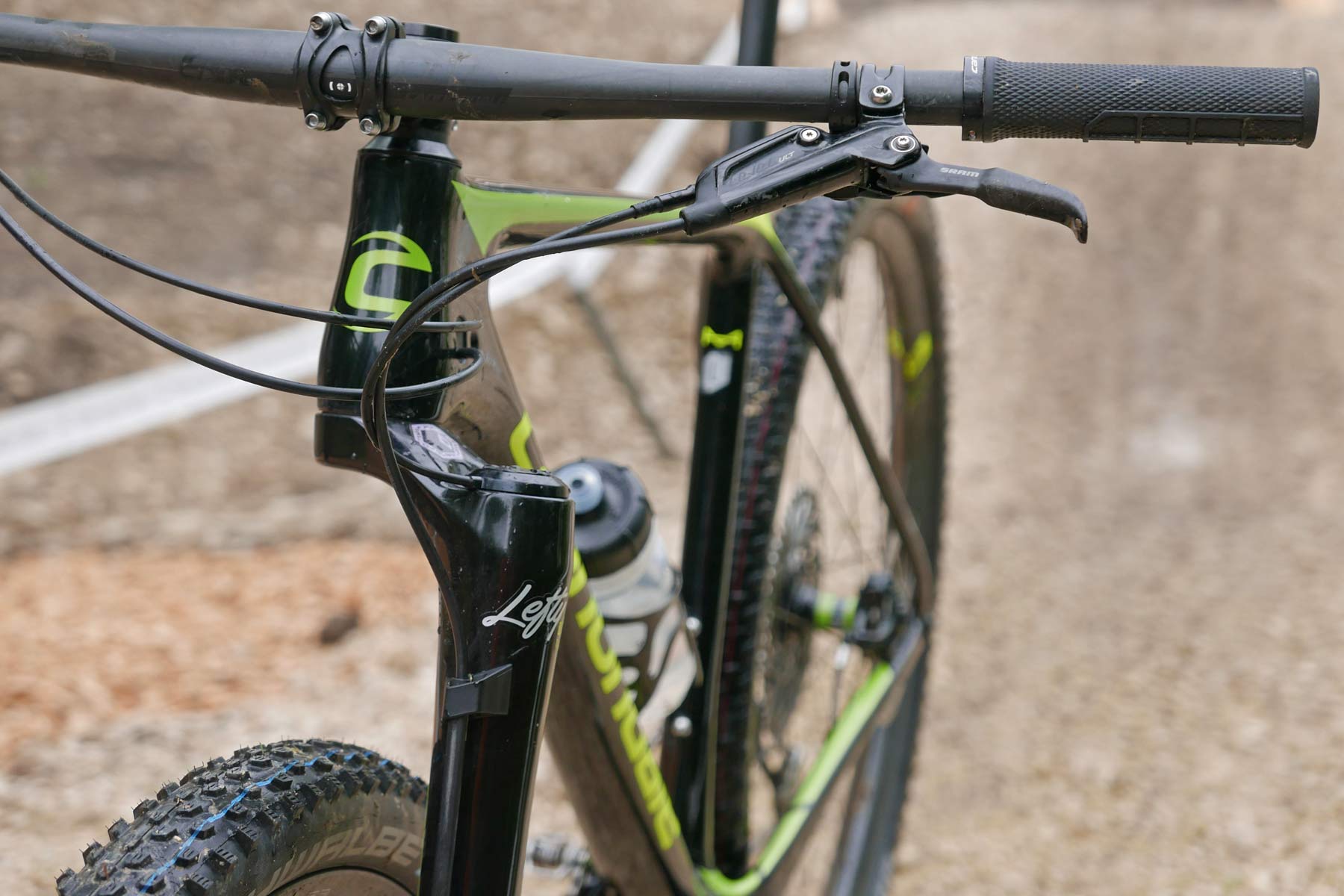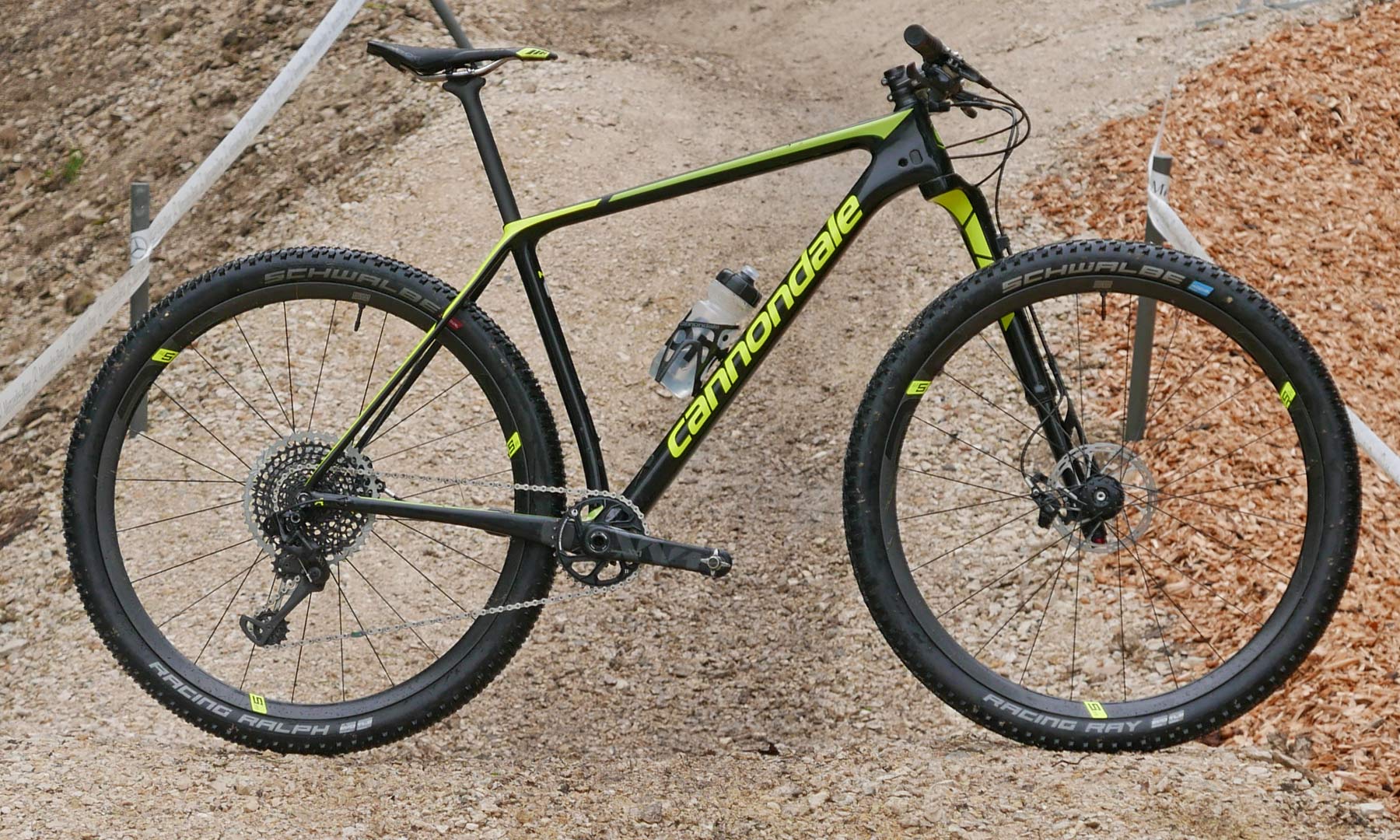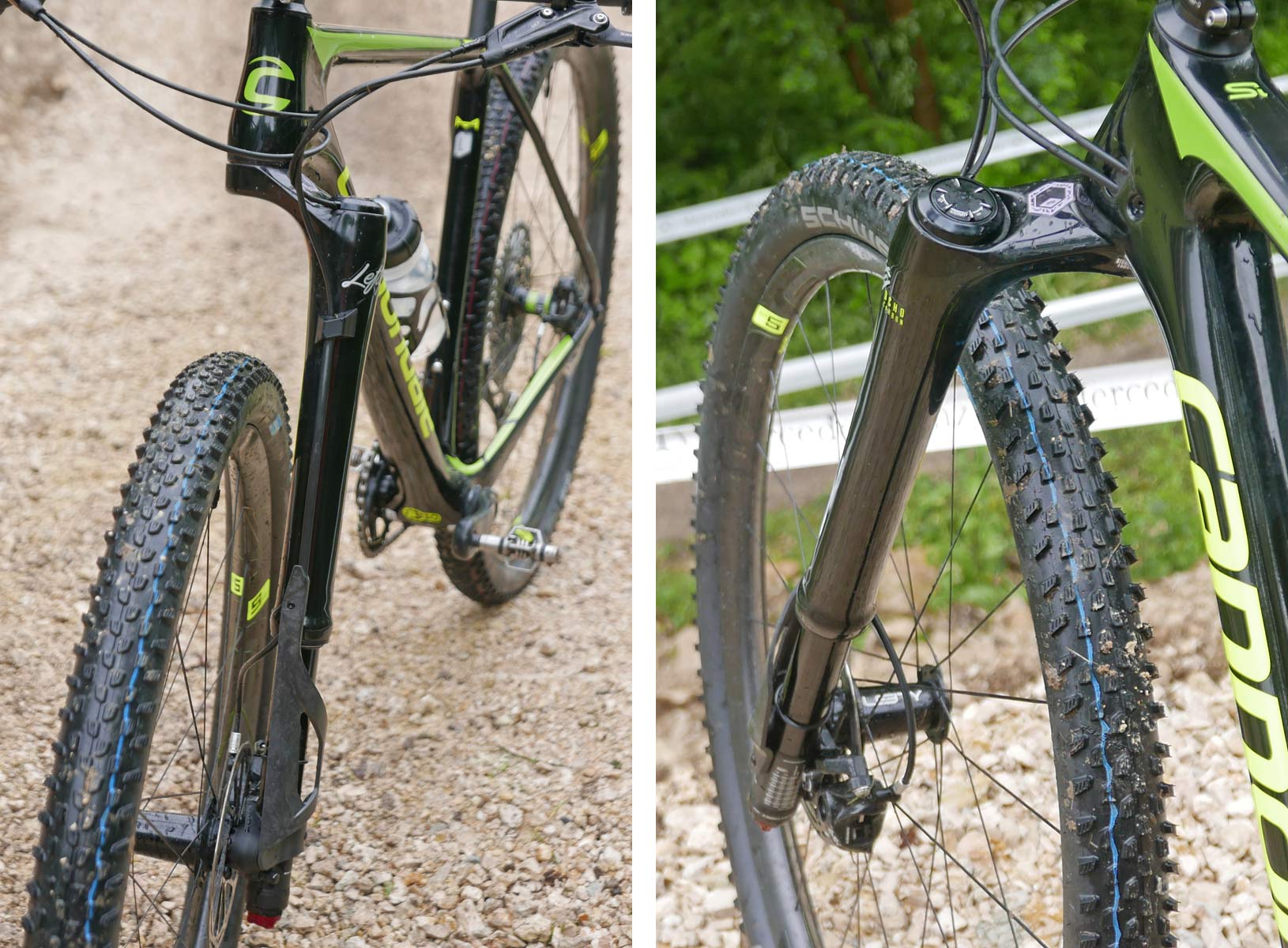Cannondale’s new F-Si carbon XC hardtail bills itself as the fastest bike for modern technical World Cup XC racing, where you have to be faster up steep climbs AND down tough descents. Its heart is still the single-sided Lefty fork, which now gets a ground-up redesign, shedding weight with a single crown & a standard 1.5″ tapered steerer design.
Cannondale F-Si carbon XC hardtail & Lefty Ocho fork
The carbon F-Si cross-country hardtail launched here in Albstadt four years ago, evolving the Flash hardtail with more of Cannondale’s signature System Integration. That Si continues building on much of the same frame tech, updated for more modern racing, and while reducing weight to be the lightest mountain bike frame Cannondale has ever made.
And now for the eighth generation of the unique one-legged XC fork, the Lefty gets an even more major overhaul. The total redesign improves pretty much every aspect of the fork, while more neatly integrating with the frame.
F-Si carbon XC hardtail Technologies
The new hi-mod carbon hardtail shaves more than 80g off over the last generation, down to 900g. That doesn’t quite make it the absolute lightest XC bike on the market. But Cannondale wanted to build a resilient bike, and says that even while dropping weight, they actually increased durability. Even the lower grade standard modulus F-Si claims a weight of just 1100g.
From a construction perspective the updated hardtail uses the same reinforced Ballistec carbon layup concept that protects areas of the frame subject to impact, while working together to provide strength & stiffness where each is most needed. That delivers the same pedalling stiffness and balanced comfortable ride performance whether on the base $2000 bike of the $9000 one.
Like we saw most notably in the Synapse endurance road bike last summer the new F-Si also adopts the Proportional Response tubing sizing design to deliver the same experience for all riders. Larger frames get larger tubing to provide more stiffness to the longer tubes (and to work for typically heavier riders). And the smaller sizes get smaller tubing to have more balanced stiffness. The size-tuned frames are less about addressing the lighter weight or lower power outputs on shorter riders, but more to overcome the common practice of designing for a M/L frame, then using the same tubing on smaller frames. Just by virtue of the shorter tubing spans, that typically makes small frames way stiffer than the comparable medium, large, and especial extra large frames.
Taking that another step further, Cannondale chose to make an XS sized bike available that uses 27.5″ wheels instead of the 29ers on the standard S-XL size run. That XS is only available in two of the standard modulus frames, but serves to give shorter riders a viable XC race hardtail option that maintains the same trail-ready geometry & handling, including its own unique fork offset to maintain fork trail figures.
F-Si carbon XC hardtail Geometry

Looking at the geometry itself a bit more, the new hardtail continues to evolve the OutFront geometry introduced on the latest XXC Scalpel. That means more trail geometry – a longer front center, increased frame reach & short stems, slack for XC 69° head angle, and a greater 55mm fork offset to deliver lower trail for more agile handling picking through technical sections.
Out back that becomes shorter 427mm chainstays for better climbing traction and cornering. That happens through an update to Cannondale’s Ai (Asymmetric integration) drivetrain offset that moves the drivetrain 6mm to the outside (3mm more than Boost) to make room for 2.35″ tires with actual mud clearance and allow for 2x drivetrains. For the rear wheels that works by using a standard Boost 148mm hub, but dishing the rim 3mm towards the disc side. At the crank it requires a special setup, with each of the bikes being fitted with a SRAM family crankset with a slightly longer spindle for the frames 83mm wide PF bottom bracket (like found on their recent full suspension bikes.) The only downside is a bit of increased Q-factor, although that could be overcome in the aftermarket by upgrading to Cannondale’s own Si cranks.
F-Si carbon XC hardtail Tech Details
Looking into the fine details, the new F-Si also adopts a Speed Release by Mavic in the back for fast wheel changes. Much like we saw on the road, it uses a bolt on axle and a slotted non-driveside dropout so you get thru-axle performance, with QR speed, not having to fully remove the axle. The system while conceptually the same as on the road, uses a different threading that was needed to handle the increased forces at play on the mountain bike.
At the same time the rear brake goes to a flat mount disc caliper standard that is lighter & simpler, like we’ve seen adopted on disc brake road, gravel & cross bikes.
The frame also uses a new integrated, wedge style seatpost binder clamp that allows for a bit more seatpost extension. It allows for 8% more deflection of the 27.2mm setapost to improve comfort while seated.
The continued use of pencil thin SAVE seatstays and tapered chainstays is said to also deliver controlled vertical compliance when standing. Better standing comfort was a significant goal of the hardtail redesign, as it happens when the XC racer is trying to use their body to damp impacts while descending. Thus lower rider fatigue through the technical sections while standing means better bike control overall and a faster rider.
The new bike uses a new modular internal cable routing setup that clamps the cables in place to prevent cable rub or rattles.
Cannondale also choose to size flat bars up to 760mm wide to give racers more control over technical courses. As they said, you can always cut them down (to the 720mm standard), but most who try the wider bars would never go back.
F-Si carbon XC hardtail paired to the new Lefty Ocho
The new single-crown Lefty now moves to an industry standard 1.125″-1.5″ tapered steerer. From a frame perspective that means that the new F-Si frames can be built with either the new Lefty fork or pretty much any other premium XC race fork on the market. Standardization is always a good thing, and this give riders more options. And even Cannondale’s engineers who have played fast and loose with making up new standards, admitted that the standard tapered steerer was a positive step, now that materials allowed them to get the same performance without the oversized & double crown setup.
Ditching the double crown also let them bring the stem down further. With the same height headtube, Cannondale was able to lower frame stack by 10mm, satisfying the #slamthatstem crowd who always demanded a lower bar position.
Lefty Ocho fork Technologies
The most outwardly obvious change to the new 100mm travel Lefty Ocho fork is the move to a single crown fork design. (With only one leg it’s actually a strut, but let’s keep calling it a fork to not get too confused.) But inside it is almost entirely redesigned to boost performance, not the least of which is the adoption of the industry standard 1 1/8″ to 1 1/2″ tapered steerer tube.
Sure dropping the double crown allowed for a lower front end, but it also mean that all of the internals that used to fit into the longer stanchion, now had to become more compact. A side benefit though was a bit less material for 250g of weight savings down to just 1446g for the new carbon XC race fork. The alloy version of the fork is as light as the previous generation in carbon at 1735g.
The other benefit to redesigning the crown was it gave Cannondale the chance to start with a clean slate. For those who accepted the unique one-legged design, the Lefty has been almost universally accepted for exceptional performance. Cannondale like to say that one-sided axles dominate so much of the wheeled vehicles that we use, so it shouldn’t come as a huge surprise. Plus, half as many legs means half as many seals for less friction, this smoother operation.
In fact the redesign left a smaller internal air volume, which actually resulted in a tune better suited to a wide range of rider weights while maintaining adjustability. It also allowed Cannondale to look at how stiffness made the Lefty outperform every other lightweight XC fork. But while front-to-back and side-to-side bending stiffness are something you can’t get enough of, many riders felt the older Lefties were too stiff torsionally – bouncing off when the front wheel glanced an obstacle. By redesigning the telescoping interface, the new fork actually 14% less torsional stiff to make it more complaint through really rough terrain. And even then, it is still stiffer in every way than all other World Cup level XC forks.
Lefty Ocho fork Tech Details
The new Lefty Ocho uses a simple cable remote lockout, and is spec’ed with a Fox lock out lever on all models that can be paired to also control a rear shock as well. At the bottom of the fork leg, the carbon Guide Guard protects the exposed stanchion/slider, while also providing a structured brake hose guide that eliminates the possibility for housing rub on the upper or any rattling noise.
The fork also gets an updated SideCar air valve just below the guard that is easier to get to with a shock pump and is said to reduce the chance of air spraying out oil where it could contaminate the brake rotor. On the bottom of the fork leg you get external rebound adjust (along with printed guides for setup, sag & rebound.) Then a new quick release Stop Lock brake mount design simplifies the rare need to remove the front wheel, with the press of a button and a half turn of an allen key.
Inside there is a lot more detailed tech updates. And we are going to get our hands on the forks a bit more in the coming days to go deep into what is really happening inside. Suffice it to say that the new self-bleeding Chamber Damper IFP delivers smoother, more consistent control; a new three-sided slider makes for more consistent bearing loading; and the new living hinge Delta Cage hold the fork’s needle bearings more precisely & gently for smoother telescoping.
Plus there is a new augmented reality (AR) Simon Service app that lets you see inside the new fork. Sure, many of its functions will be most used my shops servicing a Lefty, but it also guides riders through suspension setup and regular maintenance, explaining how the fork works, besides the service & spare parts functionality.
2019 Update: The third-party AR App that Cannondale uses seems to have gone through a number of iterations since we wrote this. The app created by PTC Inc. is currently called “Vuforia View” in the OS app store, delivering this interactive experience with its hexagonal QR codes.
The Bottom Line in the new F-Si + Lefty Ocho combo
Cannondale’s new XC race hardtail comes back to their mantra of using System Integration to build a better, faster cross-country racing hardtail capable of tackling ever more difficult pro race courses. A lighter, more durable carbon hardtail pairs with a lighter, more ride-tuned single-crown, single-sided, upside-down suspension fork. While neither frame nor fork are the absolute lightest on the market, together they shed 300g over the previous generation which was already well-received from pros & privateers.
Stay tuned over the next few days as we get out and ride the new bike in a mix of XC conditions. And check out the complete bike build specs, pricing & availability details on the new bikes here.















